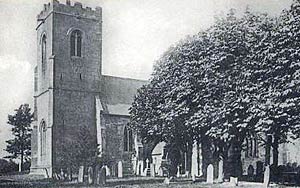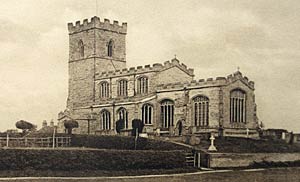< Previous | Contents | Next >
Glorious Home
NORTH LEVERTON. Gay with orchard blossom in springtime, it gathers pleasantly round the cross roads. At one end of the village is a fine windmill with sails that turned proudly as we watched the miller grind his corn, and at the other end is an obelisk to seven men who died for peace. Between them is a small church with a charming approach along an avenue of lofty chestnuts which appears unexpectedly between the houses and crosses a stream from Caddow Wood.

North Leverton church, c.1905.
The church is more attractive outside than in, and tells its oldest story in Norman masonry in the north wall of the chancel. Only a little later is the handsome doorway through which we enter, built when the Norman style was passing, the shafts on each side with capitals of stiff foliage. Among some fine 14th century windows still remaining are five in the chancel with flowing tracery. The embattled tower is 15th century, and the nave arcade comes from about 1300. There are two old piscinas, an image bracket, and buttresses with canopied niches.
With the inscription round the grave of Walter Steedman, who died in 1929, are a few bars of music engraved in gold. He kept the local post office, and loved teaching the children hymns at Sunday school. The last one he taught them was Glorious Home, and it is a line of this which is on his grave in the churchyard.
Beauty Off the Great North Road
NORTH MUSKHAM. We leave the Great North Road for this long village on a bank of the Trent. It has the shaft of the old wayside cross, a veteran windmill with battered sails, and a lovely 15th century church, its fine tower facing the road, and its east end looking across a sweeping bend of the river to Holme church mantled in trees. A ferry links these villages which were side by side till the time of Elizabeth, when the Trent changed its course in a flood and flowed between them.

North Muskham church, c.1910.
The embattled grey walls of the church are adorned with many corbels, and gargoyles of grinning figures and grotesque heads. Two crowned women smile from a window, a winged grotesque shows two teeth, and a staring jester is holding his knee.
The lowest stages of the tower are 13th century, its small west window is a century younger, and the rest is 500 years old. A splendid door of studded oak opens to a delightful interior, where bright light streaming through plain glass in most of the windows falls on white walls and stone arcades, and on a wealth of lovely woodwork old and new. The south arcade is a little earlier in the 15th century than the north, which has fragments of a Norman arcade.
The shallow 15th century bowl of the font is on a tall Jacobean shaft; its fine cover of gilded oak is new, with winged grotesques, and a charming figure of John the Baptist. The bowl of an ancient font lies in the nave, and the chancel has its old piscina.
Among old glass fragments is the tun with a bar across the head, the picture name of the Bartons, who lived at Holme in the 15th century and were good friends to the church. They built this north aisle, which has a window with 28 of their small barrels, and three buttresses showing their initials and arms in panels carved with oak leaves and acorns; there are the three bucks' heads of their shield, and their badge of a chained bear sniffing at a barrel. In the aisle hangs a copy of the will of John Barton, who lies in Holme church, his original will being in Nottingham Castle.
The east window has beautiful modern glass showing Our Lord, Paulinus, Mary, Wilfrid the patron saint, and Mary Magdalene. In the array of old woodwork are two carved chests, an armchair, the baluster altar rails, the pulpit, a Jacobean table, the door to the rood stairway with its original hinges, traceried panelling from old seats now in a screen, and the lovely roof of the nave which has nearly all its old rafters, beams with floral bosses, and figures along the sides in cloaks of leaves. One (perhaps modern) has his locks curling up instead of down and seems to be wearing a collar and tie. The chancel screen is a beautiful blending of old and new; its gates, fan-vaulted loft, and painted figures of Our Lord, Mary, and John were added to the medieval remains. The chancel roof with floral bosses is part of the modern woodwork completing the scheme.
A Crucifix shrine to eight men who died for peace was made from the wood of the old training ship Britannia. A curious memorial is an alabaster pyramid to Jhon Smith of 1591, three of its sides filled with the terms of his will.
